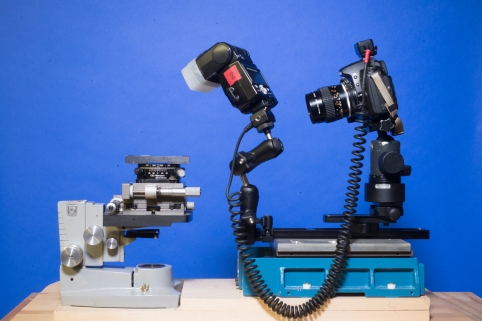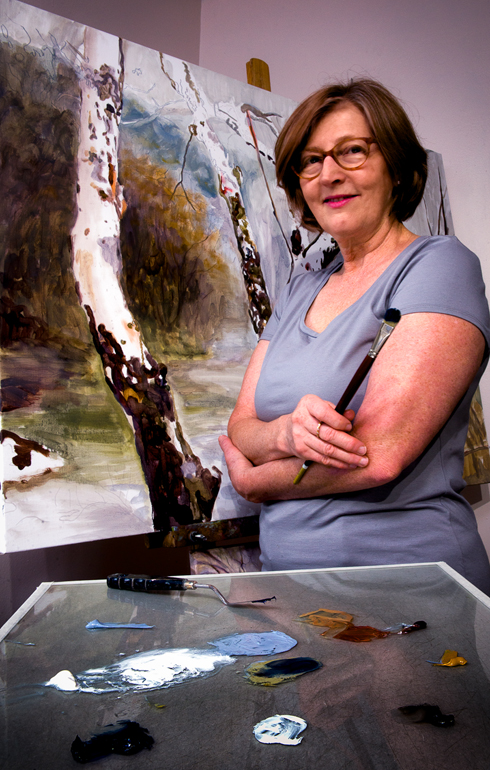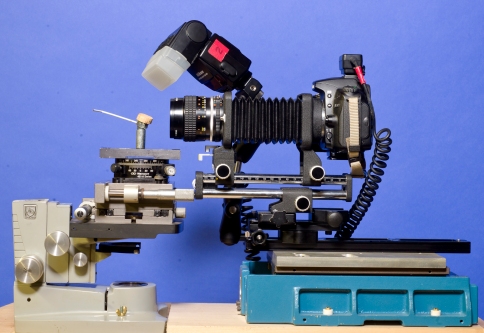This is an update of the first installment from January 22, 2014.
Commonly, when we think of close up images we envision filling the frame with subjects the size of a butterfly. When we think of macro, that subject size becomes smaller by a factor of five or so. That might be a small beetle or maybe a fly. There is a vast world that is much smaller that is worthy of our photography prowess. That is the world of ultra macro or indeed micro photography.
There are many tools used for life-sized images. The macro lens, extension tubes, bellows attachment and even microscopes. Each has its advantages, disadvantages and limitations. Some of the major considerations when doing image capture at magnifications vastly greater than life-size include, image resolution, focus, depth of field, lighting and vibrations to name a few. The micro world is a challenging one indeed.
Extreme magnification image making calls for a stable specimen and camera platform, precise and uniform movements in focus and absolutely uniform, clean lighting. In order to accomplish this a bellows and true macro lens is used with a micrometer specimen stage and electronic flash. All this apparatus may create a big problem: movement through vibrations. This really reduces image resolution.
To overcome these problems, I am have assembled a specialized piece of equipment to enable the precision required on the lab bench in a controlled environment. This is my work as is nearly completed. The idea is not new, but getting all the pieces together has been interesting. Macro work in the field requires a completely different set of equipment.
This micro set up is designed for stability combined with versatility and for use from magnifications of 1:1 or life-size on the sensor with a 55 mm macro lens to magnifications of up to to 40:1 with a true microscope lens on the bellows. It looks like this:

For smaller magnifications near life-size, the Nikon D-SLR camera is equipped with a 55 mm Micro Nikkor lens. Camera movement is facilitated by a geared linear positioner with provisions for a stepper motor, a long Arca-style plate on the positioner table with small ball head. All components are uniformly equipped with Arca-style QR clamps or plates. For greater magnifications, the camera is fitted with a Nikon PB-4 bellows with focusing rail. Various lenses may be used from the 55 mm Micro Nikkor to the 19 mm Macro Nikkor as seen in the two images below:
Subject positioning is possible in all four X, Y, Z and Theta planes. A cannibalized AO microscope stand provides coarse and fine movement in the vertical direction. A linear motion micrometer stage provides precise movement in X and Y directions and a rotation stage assembly with micrometer provides precise rotation. The specimen is held by an articulating holder mounted on the linear stage. (See Variable macro specimen holder) This holder will facilitate the use of pinned insects in addition to other larger materials fastened to the stage itself.
All this assembly is mounted together on a platform to reduce independent vibrations. The weight is substantial, providing additional aid in mitigating vibrations. The current mounting base is dimensional lumber, future refinements include an all-metal base and the addition of a stepper motor for automating focus stacking.
The design is clean and compact and without bulky tripods and other equipment in the way. The Arca-style rails provide unobstructed mounting for SB-800 or SB-910 electronic flash on a Wimberley articulated macro arm.
High magnification imaging viewing is provided via camera live view or tethered shooting on a laptop.
With this equipment arrangement deep focus stacks at high magnifications are possible in increments of 0.001 inch and at extremely high resolution with mirror lock-up and hands-free electronic remote cable release.





